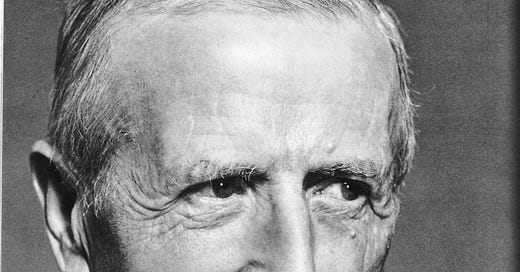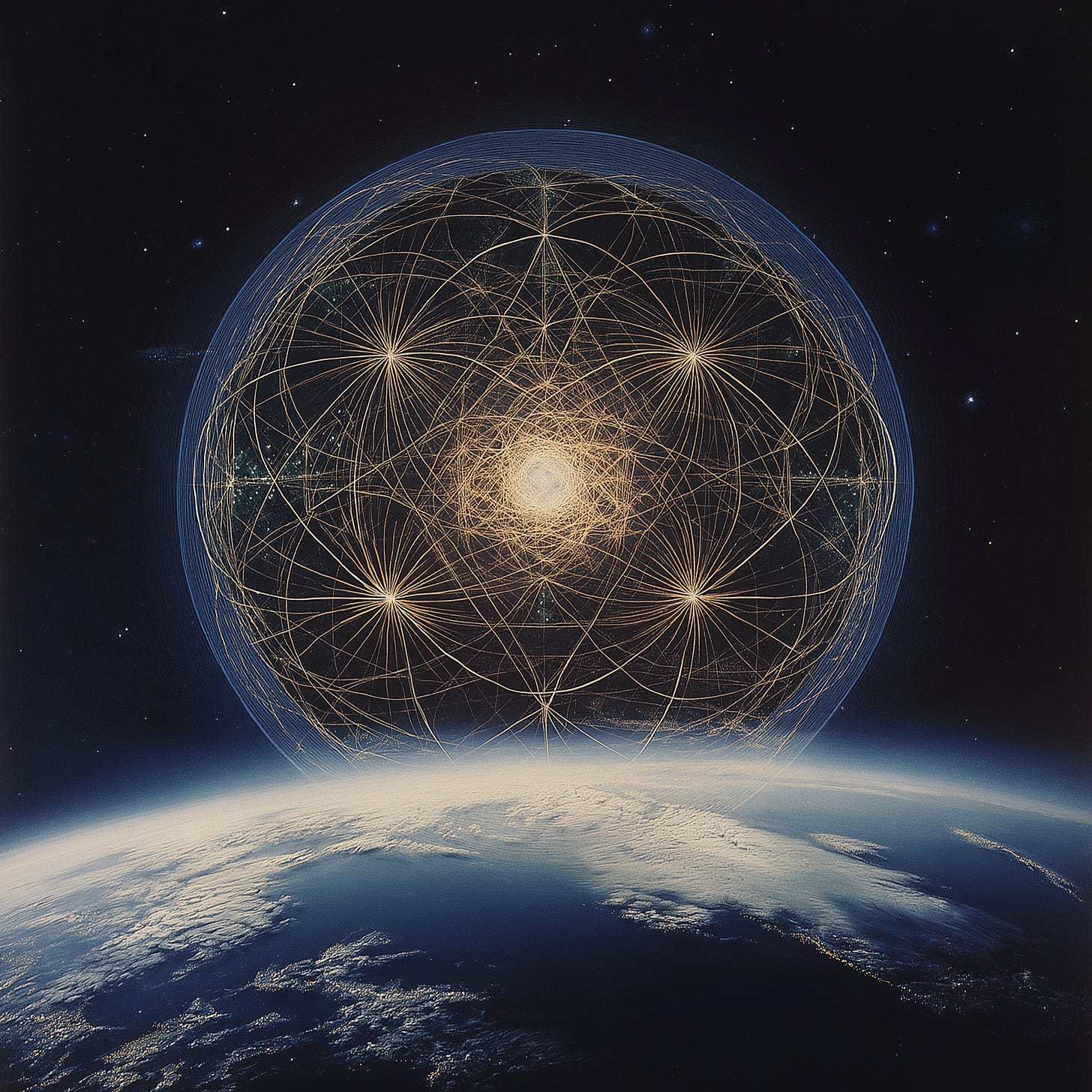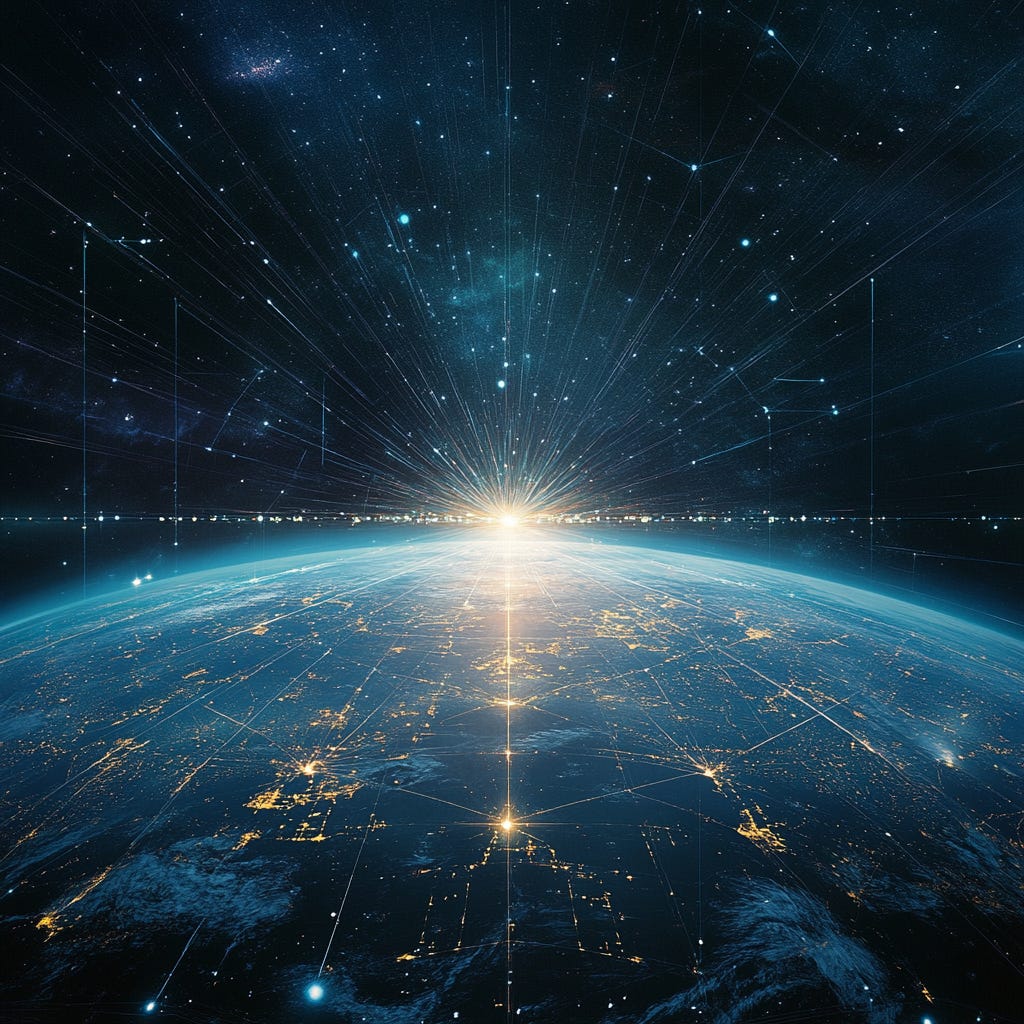Introduction:
In this two part essay I’ll to trace my fingers across the surface of the deep, dense, poetic and future-bound work of Teilhard de Chardin. This work was profoundly impactful for me and I’m glad to finally publish these essays after having them in my space for almost a year.
Pierre Teilhard de Chardin has come in recent years to rest in my mind as a kind of spiritual and intellectual grandfather. I consider his work to be a theological, scientific and poetic doorway to rediscovering the ‘way through’ our time—a sort of map for passing through the eye of the needle.
Teilhard offers a path of evolution. He does so through the possibility of spiritual and material communion as a basis for coherent human collaboration inspired by love and common soul, rather than fear or collective ideology. At the very heart of Teilihard’s work is union: first among us, and second between man and God. The process of union implies the drawing together of matter and divinity through time.
The remarkable context of Teilhard’s vision is that he not only had been a stretcher bearer on the frontline of the First World War, he wrote some of his most profound works in the midst of the darkest days of the Second World War in which all the world was in crisis. His writings were systematically rejected and at times repressed by the Catholic church, much to his pain, and their recognition only began to grow after his death in 1955.
My essay will distill small milestones from his work ‘The Future of Man’ with occasional commentary. As per the original text, any references herein to ‘Man’ refer to the great whole of mankind. Let’s begin.
We are in a time of great change, which demands great change.
Teilhard leads us into a new understanding of the scope of change occurring in our time. He outlines that this is not simply enormous change within an underlying stable context but a change in the fundamental context of life itself. The space [of play] has primacy over everything that occurs within it and this space is changing too. When we grasp this, profound questions about what we are fundamentally in and who we fundamentally are can we brought into question.
In practice, if we live in a materialistic universe then things falling apart looks pretty dire. However, if we’re actually inside a kind of evolving soul-university that things falling apart can take on a different meaning.
The depth of Teilhard’s vision as a geologist and Paleontologist brought a long long view to bear on our contemporary human evolution. He observed that the scientific revelations of the last two centuries, which we now take for granted, had actually caused a revolutionary expansion in the scale of Earth time. The depth of the past had bottomed out from a few thousands of years, to a near bottomless abyss of time extending far beyond our understanding.
This scale of time, bore upon his view of change in evolution. The greatest changes at the grandest scales whether of celestial bodies, continents or mountains all occur slowly and are often invisible to us. In general “the larger a thing is, the slower it’s movement”. With this principle, he understands man to be in the midst of a monumental and slow evolutionary movement.
We have made the error of thinking evolution has stopped but it has not, we are in a the midst of a large slow movement.
Evolution, Concentration and Hope
Man is at the leading edge of millions of years of psychogenesis. It took 300 million of evolution to develop our complex nervous systems, cognition and consciousness. In the last 30,000 years little has changed in our brain size but a far greater process of evolutionary ‘concentration’ has taken place within what’s already there. This was driven through evolutions in man’s collective consciousness, economic, social and psychic organisation. As Dawkins would later describe, evolution transitioned from biological genetic evolution to cultural evolution and in so doing fundamentally transformed.
Concentration, as a principle of evolution, doesn’t require ‘new input’. It works with synthesis and re-organisation of what is already present. When Teilhard looked out at the 20th century he sees the process of inevitable global concentration occurring on a grand scale: globalisation. The process of globalisation and increasing interconnectedness is indisputable. However, the question of how this will cohere is fundamental to our age. He saw two paths, the kinds of systems of control and ideological conformity cropping up in national socialism and communism, or something else based not on force but a ‘profound force of mutual attraction’ a gathering together brought on by ‘a common soul’. In our era, we will be forced to choose between these paths of a totalising unifying vision or unification based not upon the mind but the heart.
Noogenesis: The Meeting of Evolution and Spirit
The process of noogenesis, a key concept for Teilhard, is the emergence of a new consciousness. Like Michelangelo’s painting, Noogenesis is the meeting place of consciousness rising and spirit descending into earth. Noogenesis is the ongoing evolution of a greater reflective consciousness.
As we’ll speak to further. Noogenesis creates a context to reconcile that medieval ‘all knowing transcendent God’ and the revolutionary realisation of an evolving universe. Rather than competing and undermining faith, these two understandings of divinity are working together and reconciled in Noogenesis. In short, man and matter are ‘reaching up’ to divinity through evolutionary process and God is ‘reaching down’ into incarnation.
Interconnectedness and our Cosmic position:
The science have brought us the recognition that all matter is connected to that which came before it.
Teilhard grasps the profound implications of this ‘quantum’ reality expressing a kind of great chain extending from every form in “an indivisible thread back into infinity”. We are part of a great ‘organic whole’.
This “interlinked system of lines of indefinite length, the stuff of the universe…radiates outwardly from ourselves, without limit, spatially from the immense to the infinitesimal, temporally from the abyss of the past to the abyss of the future…in this endless and indivisible network, everything has a particular position defined by the development of the entire system in movement.”1
From this standpoint all human forms express a movement of the cosmic whole, we are the movement of that light infused matter that traces back to infinity. Whatever circumstance a human being finds themselves in, this profound provenance and interconnectedness is always present in the background. The very matter of our existence traces back through the great chain of being to the dawn of time and to its source, infinite God.
Man is concentration and synthesis:
Man is the fruit of a profound process of convergence and synthesis “a long chain of composites” from proteins to viruses, bacteria and metazoa. The very experience of time itself is an expression of the “rise of the universe into those high latitudes where complexity, concentration, centration and consciousness grow and increase simultaneously and correlatively”. In other words, the very fabric of time as we experience it, is a consequence of the centration of matter into a time-experiencing consciousness.
The discovery of evolution had caused a deep crisis by displacing man from his biblically endowed position as God’s steward of all life. The simplicity of the eden story being undone, lead to a contradiction between science and religion as ways of knowing. Man would increasingly become just another part of the chain of evolution, simply the next adaptive extension of all animal life.
One of Teilhard’s biggest contributions to humanity is to undo and trump this conflict. He reframes with his new vision that man is the spearhead of evolution, that this process is divine, and unfinished and that man lives at its very horizon in the process of noogenesis.
Looking backward’s he reads a process of greater and greater synthesis of matter into consciousness. Looking forward he envisions then that time is conic, literally that “space-time is convergent in its nature” and that we have yet to reach the “ultimate point of its evolution”. This being the case, there is still “formidable potential of synthesis” and “our present situation cannot be anything but ‘energetically’ unstable. We cannot stay where we are at present physically or psychically…we thought we had reached the limit of ourselves. Now we see mankind extending within the cone of time above the individual; it coils in collectively upon itself above our heads, in the direction of some sort of higher mankind.”2
Teilhard’s reading of the evolutionary arc of centration and increasing complexity, casts a view forwards—a conic movement of time. From a wide point, increasingly converging in this centration of consciousness, that conic form points towards some ultimate: The Omega point. The Omega is one of the most profound notions in Teilhard’s work, pointing to an inflection point of spiritual and physical consummation with divinity. Herein we can see beginnings of a profoundly christic evolutionary science.
He believed, rightly, that recognition of this spiritual-evolutionary trajectory could deliver a great gift to mankind. That we could realize that “the universe is illumined from within” and that there is hope ahead in “the existence of a higher centre of consciousness…at the apogee of evolution”. Something both “ultra-conscious, ultra-personalised, [and] ultrapresent”.
A Christian Evolution
The Omega point has eschatological tones but is offered as a scientific notion not just a theological one. The role of Christ in history expresses the re-uniting of spirit and matter. These, having been perceived as in some way separate in a dualistic fallen world, are made whole in the person (or consciousness) of Christ.
Teilhard’s evolution, in rhythm with John Vervaeke’s relevance realisation, flows upwards and downwards. Spirit is emerging in matter and drawing upwards, through centration and synthesis, at the same time divinity is reaching downwards.
At the horizon of the cone of evolution, at the omega point, is christ, a spirit radiating ‘backward’ through all ages and acting upon the very forces of evolutionary convergence.
Life and the Planets
Teilhard flexes his extensive scientific understanding in several detailed chapters on astronomy; describing how the life of the stars mirrors the evolution of man. The stars function as “laboratories of nature” in which different levels of complexity can develop. The complexity of this organic life is not measured by the number of atoms but by their degree of connectedness. In the same way, man’s unique consciousness is a product of his ultra-complexity. The evolution of man is not afforded by ‘adding more’ so much as this increase in complex interconnection.
Planetisation and collectivisation:
A fundamental assumption in the modern era has been that man on the planet has reached the pinnacle state of humanity. Teilhard rejects this foundationally.
He points to the world around us and myriad forces of ‘collectivisation’ through economic bonds, interconnected networks, totalising political regimes, greater proximity between all peoples and nations. We are in the midst of a process of intensifying pluralism which, as O.G. Rose describes in Belonging Again, is inevitable. Teilhard writes, we see “the rise, in every form, of the other around us” and, while he couldn’t predict AI, it certainly fits within this description.
Ultimately this increasing interconnectedness and confrontation with otherness is neither arbitrary or a misfortune but a key catalyst of evolution.
Planetisation
Matter has been organising itself together in an ongoing process of synthesis long before complex molecular life. This process he traces from from the deep history of elements to preset day animal evolution. This process of synthesis, re-organises that which is already present to afford the process of human cultural evolution. Where he takes a step beyond evolutionary orthodoxy is to recognise that the phase of totalisation (total planetary interconnectedness) that we are approaching represents a climax of this process which is fundamentally observed in the evolution all organised matter. As proteins formed cells, so cells formed complex life, complex life formed civilisation and civilisation now develops into the noosphere. In Teilhard’s words:
“Mankind born on this planet and spread over its surface, coming gradually to form around its earthly matrix a single major organic unity, enclosed upon itself; a single, hyper complex, hyper centred, hyper conscious, arch-molecule co-extensive with the heavenly body on which it was born…the closing of this spherical thinking circuit”
From the end of the road to a new door
If we see ourselves as having reached our highest point of evolution then the future, Teilhard argues, will become foreclosed and we will have reached the end of the road. It’s a sentiment which bears out resonance with the ‘end of history’ that we have lived through at the turning of the century. The re-vivification of a human evolution, has now branched off in various directions with hope and home vested into the immortal promise of the transhuman and into the ‘great other’ of AI rather than a divinely informed collective evolution.
Looking out at the end of history Teilhard asks us what if man sees “a new door opening above him, a new stage for his development”? if he can do this he will find a “a new spring of energy…and press on with strength renewed”. Teilhard’s faith in the future is a core and vitalising one which is quoted at the opening of The Future of Man from one of his letters to Mme Georges-Marie Haardt:
“The whole future of the Earth, as of religion, seems to me to depend upon the awakening of our faith in the future”
At this great turning, mankind is faced with this pathway of a totalitarian totalisation that crushes the individual in service of a kind of global machine, or to turn towards this elegant organisation that arises through ‘internal attraction’—to be drawn together by a common spirit into a higher synthesis of more deeply bound and more deeply personalised human beings.
Common spirit, personal Love
Mirroring the oft qouted Dostoevsky story in The Brothers Karamazov in which one of the protagonists seems to ‘love humanity’ but ‘loathe man’, Teilhard brings forward a christian insight into common love. He says it’s not sufficient to feel ‘a part of a whole’ in abstraction or as a kind or empathic progressive ideal, we must experience that love in a fundamentally personal way, ultimately realising that we are part of ‘the same person’. It points to an recognition of our fundamental co-emergence from the same divinity and for this to be landed in direct personal experience not held as abstract ideal—no easy task.
This sense of the ‘same person’ also alludes to the essential role of the Christ in affording this sense of unity possible. It is through the Christic Omega point that man can begin to realise the common spirit of christ in all things. The omega point is a ‘cosmic spiritual centre’ and ‘supreme pole of consciousness’ radiating through space and time upon which may can progressively converge. Contrary to the subtle and overt collectivist tendencies of ideological movements and many religions, Teilhard stresses that “True union…the union of heart and spirit does not enslave, nor does it neutralise the individuals which it brings together”. True union with the divine profoundly individualises, and from this profound uniqueness there is a drawing together on the basis of common soul & common love.3
“And since Christ was born, and ceased to grow, and died, everything has continued in motion because he has not yet attained the fullness of his form. He has not gathered about him the last folds of the garmet of flesh and love woven for him by his faithful. The mystical Christ has not reached the peak of his growth…and it is in the continuation of this engendering that there lies the ultimate driving force behind all created activity…Christ is the term of even the natural evolution of living beings”
This paper by no account can be considered exhaustive and is merely an effort to clarify and transmit some of the beauty and wisdom of his work. If you’re inspired I encourage you to take to Teilhard’s writing directly!
Subscribe to receive part two of this essay revealing further insight into the spirit of the Noosphere, the future of Man & the spiritual repercussions of the Atom Bomb.
Teilhard de Chardin, The Future of Man, [Harper & Row, NY, 1964]p.88
p.92
p.126









I look forward to reading more about Teilhard de Chardin. I have been interested in his work for many years.
So then is it just simply about "faith" and that by simply fixing one's feet to the floor the great unfolding will carry us through? The faith in (simply) collective wisdom is an evolutionary empowered metaphysics and that individual choice of faith in Christ is enough?
A personal tussle is trying to contemplate noogenic phenomenology as not intrinsically resident in AI. What of the relationship between man and machine in the realm of spirit? A sort of offloading from the human enterprise is possible? If Teilhard can convince me that silicon is a healthy outcrop from carbon, just as he (you) describe the history of molecular synthesis then perhaps the answer to magnitudanal intelligence as the "devil's work" can be investigated?